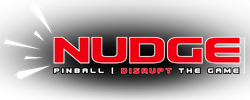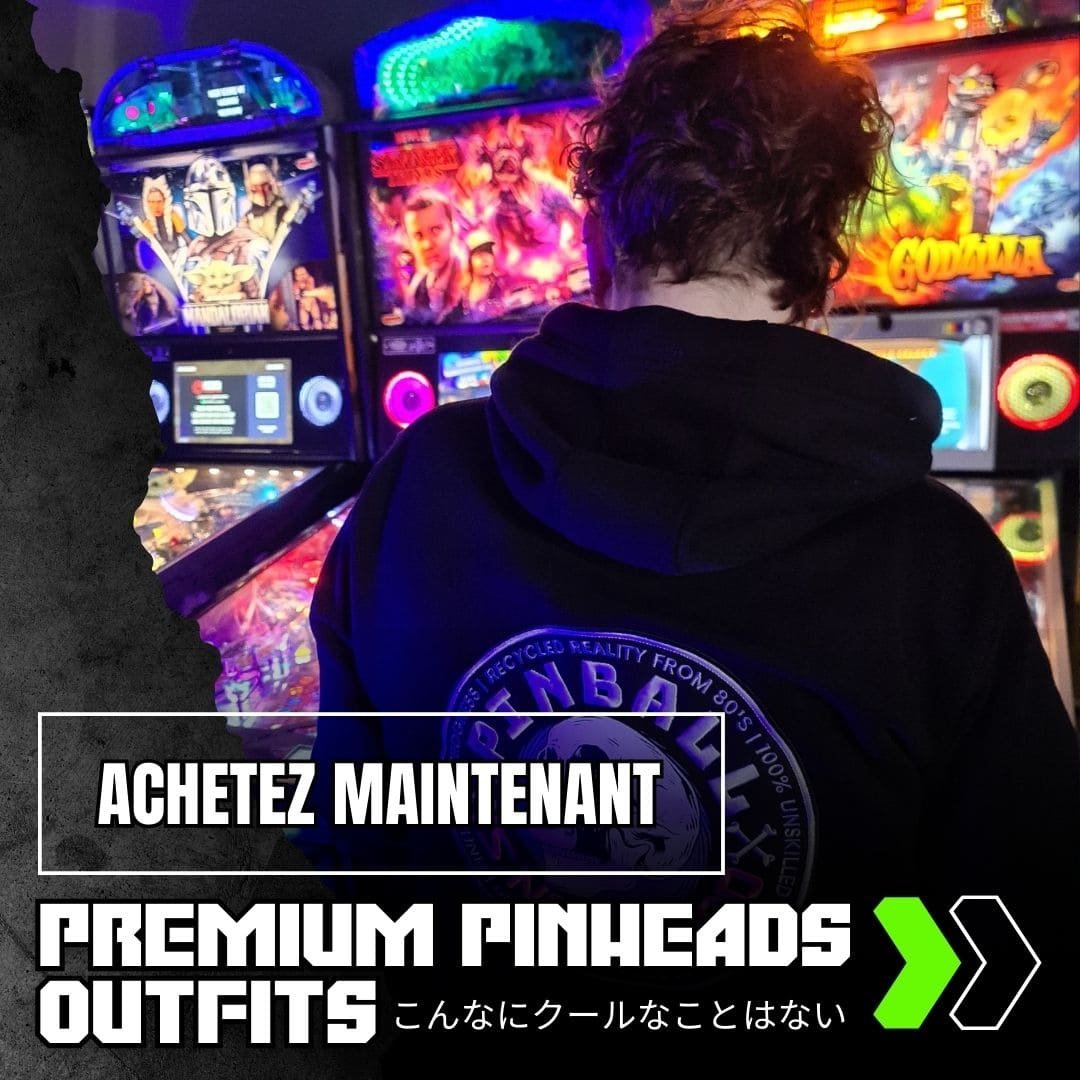I have a particular fondness for Gottlieb pinball machines, which are the ones that instilled in me a passion for pinball. That’s why I wante to share this retro review with you, to help you discover or rediscover one of the brand’s legendary pinball machines, described by some as the best System 80B ever. Yes, today we’re talking about the legendary TX-Sector game.
Sommaire
- 1 TX-Sector: a typical System 80B pinball machine
- 2 Backglass and bodywork: the TX-Sector’s weak point
- 3 The theme: science fiction
- 4 A rich playfield
- 5 Trajectories on the playfield
- 6 A clever hologram effect!
- 7 TX-Sector: an exceptional soundtrack
- 8 The Alphanumeric screens
- 9 Unique Teleport gameplay
- 10 Scoring: you’ll have to farm!
- 11 The technical side of the Transphazer
- 12 TX-Sector: the Gottlieb hit
TX-Sector: a typical System 80B pinball machine
TX-Sector is a Gottlieb pinball machine released in March 1988 and produced in 2,336 units. Designed by John Trudeau, the playfield embodies the mechanics typical of the Gottlieb pinball machines of those years, which we’ll come back to later.
On first contact with the machine, we notice a striking blue alphanumeric display, positioned at the top of the backbox, between the speakers on a sloping panel covered with silk-screened Plexiglas. As connoisseurs will have gathered, this layout is typical of some System 80B pinball machines.
Backglass and bodywork: the TX-Sector’s weak point
Beneath this panel, we see the rather mysterious backglass, with a glimpse of the pinball logo and a character in a jumpsuit who seems to be splitting into two. The whole thing is set against a light-colored background in shades of red and yellow, with scenery reminiscent of a factory and a deep black void with a streak of red running through it… This is considered the weak point of this pinball machine by some, although it hides a surprise that I’ll tell you about next.
The box, in black tones, is relatively simple, with a large red “TX-Sector” logo on the left and right. The front features red and white geometric lines on either side of the door, with a “TX” logo. Initial entry buttons under the plunger are typical of Gottlieb alphanumeric flips.
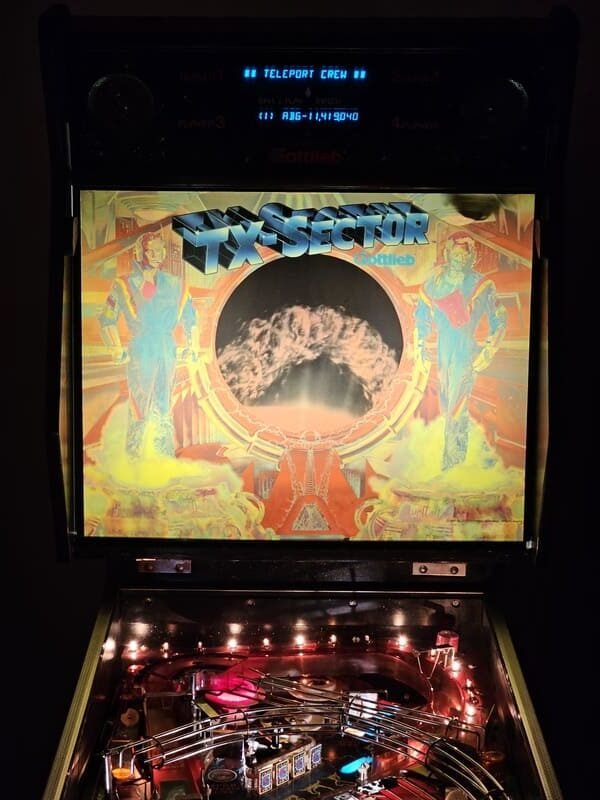
The theme: science fiction
From these elements, the theme seems obvious: this is a science-fiction pinball game. These mysterious graphic elements, these factory/space-style settings, this character who splits into two… We quickly understand that we’re going to have to experiment with all this in the gameplay, and you’ll see, it’s brilliant!
A rich playfield
In addition to the wonder of the right-hand ramp lightshow and its 15 miniature bulbs, we’re faced with a well-stocked playfield, especially at the upper part. The layout, from left to right, is as follows:
- At the bottom left, we see the usual pairing of inlane and outlane, plus a standard-size slingshot.
- Just above the latter, a “kicking target” – a mechanism much used by Gottlieb, and also found on Stern’s Foo Fighters (hold it…) – sends the ball back in the same way as a slingshot, but in a downward direction.
- Above, a third flipper provides access to the right-hand shots.

Trajectories on the playfield
Moving on to the shooting axes, the leftmost shot leads to a fixed “MEGA-PORT2” target which, depending on the game phase, can score :
- 10,000 points,
- 1 level,
- an Extra-Ball
- or a special.
To its right, we note a ramp protected by a drop target. The “Tele-Port” inserts are visible in front of the ramp, and there’s a light under the plastic at the top of the ramp, flashing faster and faster as you count down, which is an interesting indicator.
For the central shots, we’re faced with an unstructured layout. In the middle, we find a row of 4 drop targets, slightly tilted to the left so as not to be too punitive, accompanied by 1x, 2x and 3x inserts. These are used to obtain levels.
To the right and left of the latter, and at two different heights, two corridors equipped with a spinner worth 1,000 or 10,000 points, lead up to the Infinity Zone, the upper part of the board. The Infinity Zone, with its three bumpers, allows you to slow down the timers and hit a fixed target that gives two levels per shot.
On the right-hand side of the playfield, at the upper part, in line with the row of falling targets in the middle, we first find a tunnel with “Tele-Port” inserts. This can be reached with the top flipper, but a bounce on the drop targets will also take you there.
Just below this tunnel, in line with the upper flipper, we find a large, luminous red ramp running across the top of the playfield. Note here the third pair of “Tele – Port” inserts. Below this ramp, and quite far towards the middle of the playfield, the second row of 4 drop targets and their inserts allow energy levels to be collected. Finally, on the right of the row of targets, a shot leads to the target “Mega Port 1”, which offers the same rewards as the one on the left.
Finally, the bottom right-hand section is identical to the left, but “Emergency Re-Entry Portal” studs located in the outlane allow you to save your marble and bring it back to shooter lane. Shooter lane, by the way, sends the ball up a ramp to the upper left flipper.
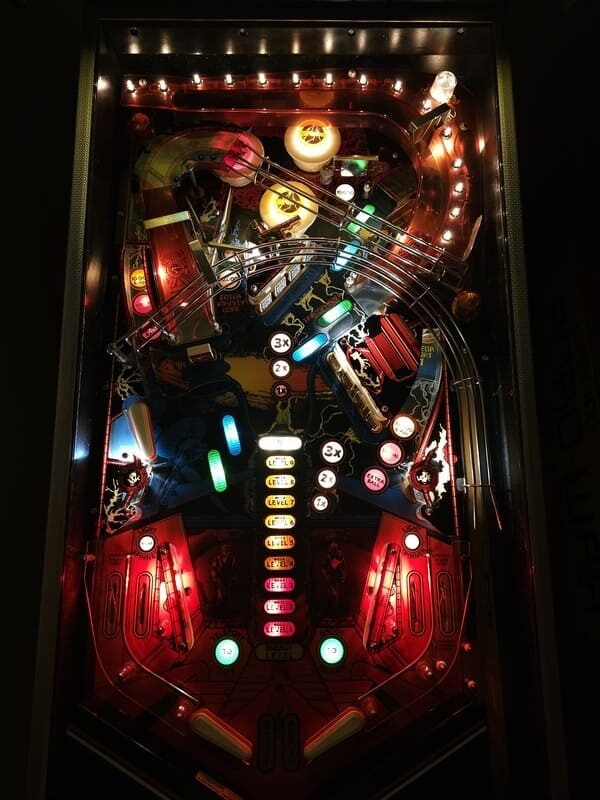
A clever hologram effect!
This playfield is decorated with red tones and industrial-style decorations at the bottom. In the center is a large tank with multiple MEGA LEVEL inserts, ranging from 1 to 10 (lock).
The upper part, on the other hand, is darker, in black tones, revealing less decoration. We can, however, see a red streak running through the bumpers area, and it’s precisely this surprise that I mentioned above. In fact, when the player stands in front of the machine, the red streak on the frontglass is reflected in the red streak on the playfield, creating a hologram effect. As this effect is difficult to capture on film, you’ll have to take my word for it 🙂
TX-Sector: an exceptional soundtrack
Before talking about the gameplay, I’d like to talk about the one thing everyone agrees on about this flip: the soundtrack and sound effects. Indeed, what a slap in the face!!! The sounds produced by Gottlieb’s chipset, highly advanced for its time, propel the player into another dimension.
The music is lively, catchy, rhythmic and features ultra-melodious synthesizer tones, all backed up by surreal SFX as the player aims and shoots the various targets and shots on the playfield. The machine’s speech is composed of two voices: a robotic male and a female, which complement and blend perfectly with the rest of the sounds. In short, this is one of the best pinball soundtracks ever produced.
The Alphanumeric screens
In the Internet videos, it takes a while to figure out where the alphanumeric displays on the TX-Sector pediment are. In fact, they’re positioned above the backglass, at the very top! On most pinball machines, they are located below the backglass.
This arrangement is rare, both with Gottlieb and with all manufacturers in general. The intention was to make it easier for spectators to read the score.
Apparently, this innovation failed to convince, as it can only be found on four Gottlieb machines, and (almost) nowhere else:
- Diamond Lady
- Robo-War
- Excalibur
- TX-Sector
One hypothesis for the lack of success of these screens at the top of the pediment: the screen is less visible to the player during the game. And mission pinball machines, which pass on instructions for actions to be carried out via the screens, make this visual proximity to the player indispensable. Yet, missions were introduced around the same time as the TX-Sector game, with alphanumeric screens and the first DMDs (screens with orange dots).
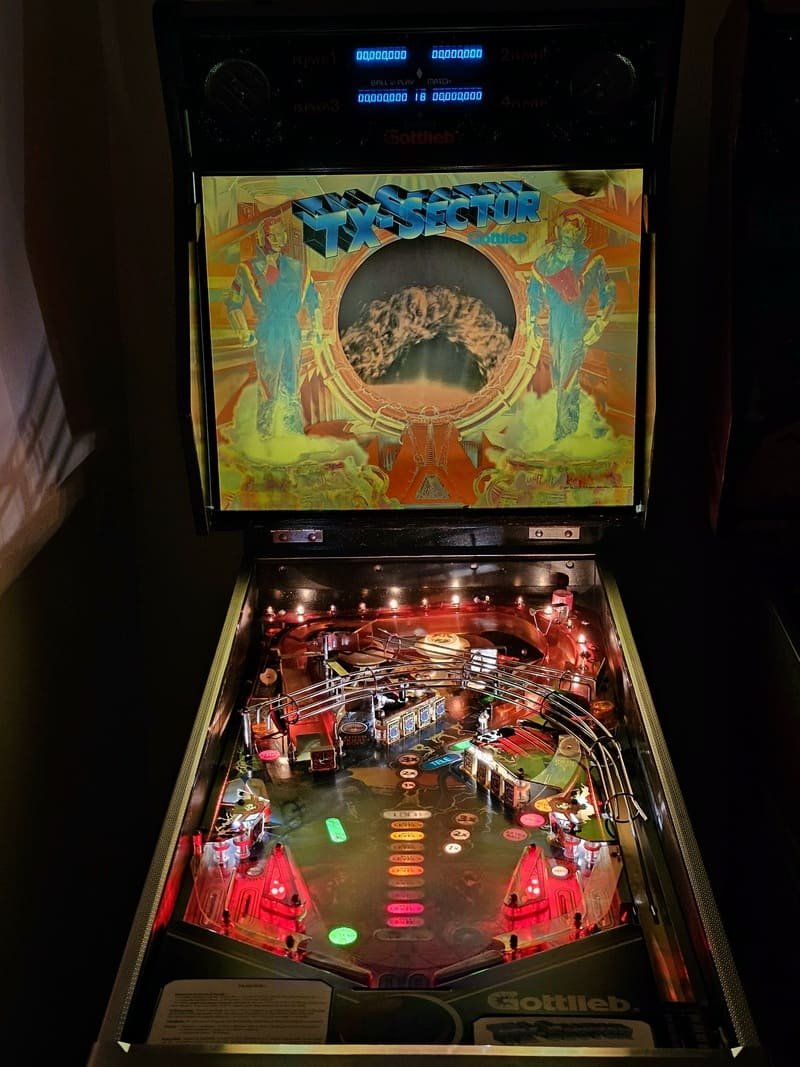
Unique Teleport gameplay
Right, and now for the thing you’re probably most looking forward to, we’re going to talk about the gameplay! Let’s get off to a great start: as some of you will probably have gathered from the description of the playfield, the “Tele” and “Port” inserts actually mean that the ball will teleport! You read that right, the main feature of this pinball machine is the presence of a ball teleporter, called the Transphazer. This teleporter, unique in the world of flip machines, opens up a whole new range of gameplay possibilities, and is the pinball machine’s undisputed source of attraction!
So how does it work? Technically, I’ll come back to that at the end of the article, but gameplay-wise, here’s how it works: When you start a game, a passageway to the Transphazer is lit up, so it can be accessed either via the right-hand ramp in the first case, or via the tunnel and left-hand ramp in the second. As soon as your ball lands in the Transphazer, the magic begins… In a spectacle of lightshow and sound, each more incredible than the last, your ball teleports and physically exits, at the MEGAPORT corridor opposite the one from which it started.
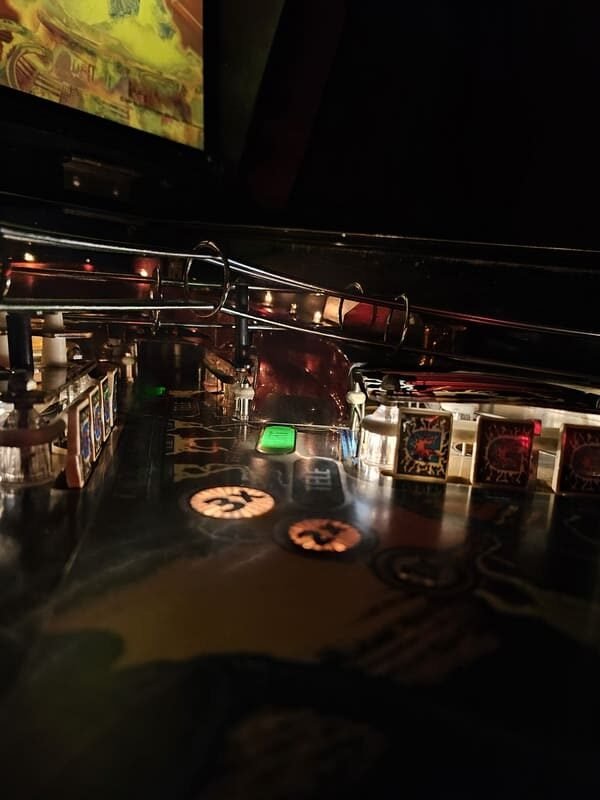
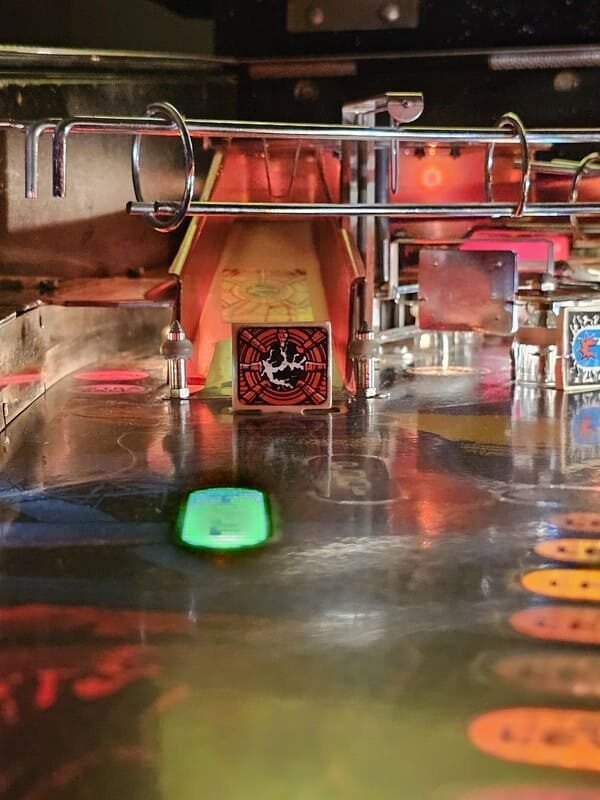
Scoring: you’ll have to farm!
Scoring is just as crazy. You’ll earn between 10,000 and 990,000 points depending on your energy level and the value of the Teleport Multiplier, a countdown that starts when the target in front of the left-hand ramp is shot down.
Note that this target falls on its own when you take the right-hand inlane, provided that the teleporter is active in the left-hand ramp. The energy level, meanwhile, is gradually increased by several shots: the side MEGAPORT targets, the drop targets, and the fixed target hidden in the bumpers. Levels range from 0 to 10, and the lock is activated when the level reaches its maximum. Teleporting then starts the multiball.
For the rest, the spinners, positioned at the two entrances to the Infinity zone, can be switched on to give 10,000 points per turn via the inlanes. The bumpers give 1,000 or 10,000 points depending on whether or not they are switched on. Finally, just about every other shot and switch on the board scores between 3,000 and 30,000 points.
And that’s how the rules work in general terms. So this is a pinball game where level farming and speed are the order of the day, allowing you to multiply the scores obtained in the famous Transphazer!
The technical side of the Transphazer
And for those who really want to know how the Transphazer works, it’s an ingeniously simple design.
A captive ball is stored either on the right or left side of the playfield, and the teleporter lights up on the opposite side. When you enter the teleporter, the ball is stored, and the captive ball on the other side is released, in a light and sound show.
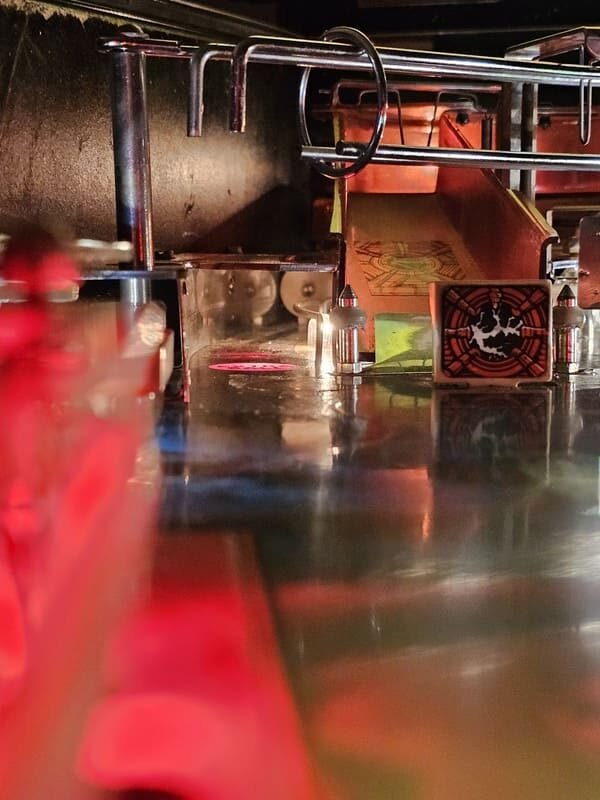
TX-Sector: the Gottlieb hit
To conclude on this pinball machine, you’ll have understood that this is a hit from Gottlieb. The TX-Sector table offers captivating rules and a captivating main feature.
There are no missions to speak of on the machine, as with most machines of the late ’80s, but the concept of energy levels and multipliers rounds things off, so that a game is always rich and varied. What’s more, the rhythmic synthesized music and various lighting effects immerse the player in the atmosphere. Press start and off you go… TX, TX, TX…
